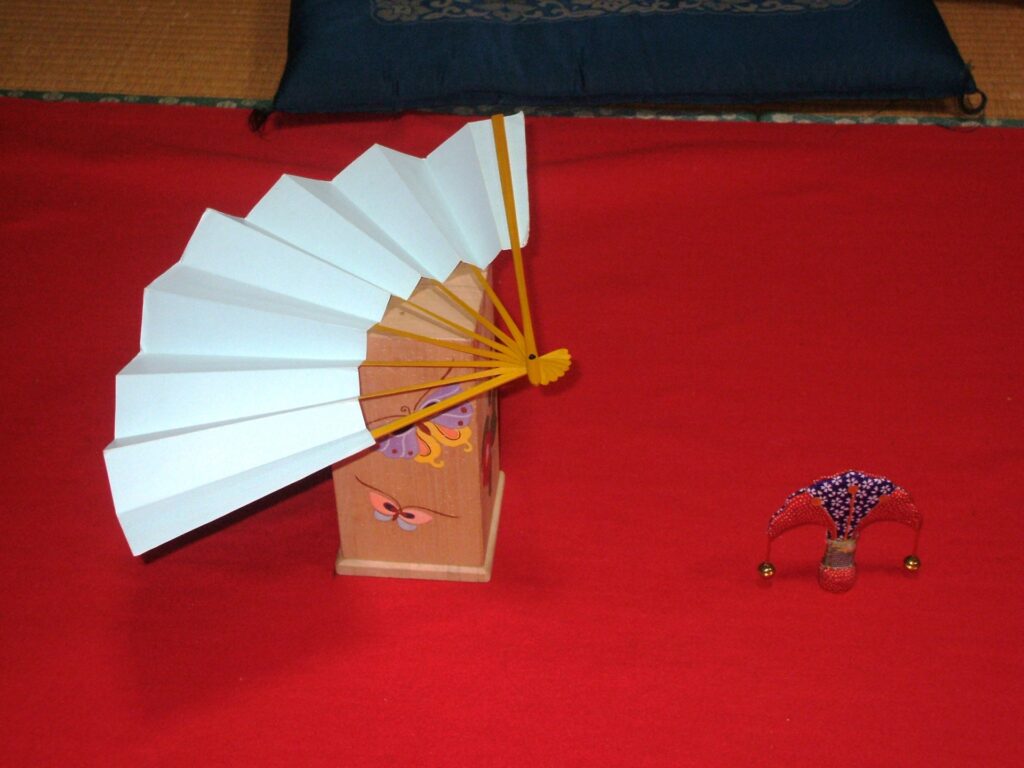扇を投げて的を落とす、優雅な日本の伝統遊戯「投扇興」。
その響きから平安王朝の雅やかさを想起される方も多いかもしれませんが、実はこの遊びが生まれたのは江戸時代。町人文化が花開いた頃、京都や大阪を中心に、庶民の間で流行した“風雅な遊び”です。
遊び方と見どころ
台の上に「蝶」と呼ばれる銀杏(いちょう)形の的を立て、約一メートル離れた位置から座って、開いた扇を投げます。
扇と的が落ちた位置や形を「源氏物語」五十四帖になぞらえた図式に照らし合わせて採点し、点数を競う――というのが基本的な形式です。
この源氏物語形式のほか、「百人一首形式」など地域ごとに独自の採点法があり、全国にさまざまな流派が伝わっています。
投げる扇は特別に作られたものを用い、的の「蝶」は美しい塗り仕上げの木製。落下後の形の美しさも評価の対象となるため、力だけでなく、所作や姿勢、扇の舞い方にも“美”が求められるのが特徴です。
起源と歴史
安永2年(1773年)に刊行された『投扇興図式』の序文によれば、投扇興は京都で誕生したと伝えられています。
一方で、『武江年表』という文献では大阪発祥説も見られます。いずれにしても、上方文化の中で育まれた遊戯であることは確かです。
その原点は、中国から伝わった「投壺(とうこ/つぼうち)」という遊戯にあるとされています。
投壺は壺に矢を投げ入れる宮廷の遊びで、日本ではこれを“扇”と“蝶”に置き換えることで、より繊細で詩的な遊びに昇華されました。
つまり、投扇興は東洋の雅と江戸の風流が融合した、日本独自の文化なのです。
現代に伝わる投扇興
現在でも京都や東京では、茶道や華道と並ぶ「お座敷文化」の一つとして伝承され、祭りや観光行事で体験できる機会もあります。
扇を投げる瞬間の静寂、的を落としたときの軽やかな音、そして形の美しさを競う――その一連の所作の中に、“日本の美意識”が凝縮されています。

Tōsenkyō – The Elegant Game Born from the Common People
Tōsenkyō, literally “fan tossing,” is a graceful traditional Japanese game in which a fan is thrown toward a target.
At first glance, it evokes the refined atmosphere of the Heian court, yet this pastime actually originated during the Edo period, when Kyoto and Osaka’s townspeople culture flourished.
What began as a playful entertainment among the common people soon became an elegant art of motion, grace, and competition.
How It’s Played
A wooden stand holds a small fan-shaped target called the chō (“butterfly”).
From about one meter away, players sit gracefully and toss an open folding fan toward the target, aiming to knock it down.
The way the fan and target fall is compared to patterns based on The Tale of Genji’s 54 chapters, with points awarded according to their form.
Other styles exist throughout Japan — for example, based on the Hyakunin Isshu (One Hundred Poets) — showing the creativity and regional charm of this cultural pastime.
The fan used for the game is specially crafted, and the “butterfly” target is beautifully lacquered.
Because elegance of motion counts as much as accuracy, players must combine skill, posture, and aesthetic sense — making each throw resemble a refined performance.
Origins and History
According to the preface of Tōsenkyō Zushiki (1773), the game was first played in Kyoto.
Another document, Bukei Nenpyō, claims Osaka as its birthplace — but both agree it arose from the vibrant “Kamigata” (Kansai) culture of the Edo period.
Its roots can be traced further back to the ancient Chinese game Tōko (pitch-pot), in which players threw arrows into a vase.
When this idea reached Japan, the arrows and vase were transformed into the fan and butterfly, reflecting a Japanese sense of subtlety and beauty.
Thus, Tōsenkyō became a uniquely Japanese expression of elegance — where motion and stillness coexist in perfect harmony.
Tōsenkyō Today
Even today, Tōsenkyō survives as part of Kyoto’s ozashiki (tatami room) culture, alongside tea ceremony and flower arrangement.
Visitors can experience it at cultural events and festivals in Kyoto.
The quiet moment before the throw,
the soft flutter of the fan,
the gentle fall of the butterfly —
within these delicate movements lies the essence of Japanese aesthetics.




コメント